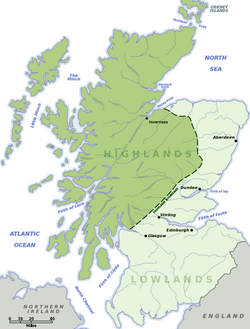Scottish Highlands
The Scottish Highlands is a historic region of Scotland. It is the area to the north of the Highland Boundary Fault. The fault separates the hard igneous and metamorphic rocks to the north from the softer sedimentary rocks of the Scottish Lowlands in the south.
 | |
Coordinates: == Scottish Highlands Media ==
| |
| Time zone | GMT/BST |
The Highlands are divided in two parts. The Great Glen divides the Grampian Mountains to the southeast from the Northwest Highlands.
Population
The area is generally sparsely populated, with many mountain ranges, and includes the highest mountain in the British Isles, Ben Nevis.
Before the 19th century the Highlands was home to a larger population but, for several reasons, the area is now one of the most sparsely populated in Europe. The average population density in the Highlands and Islands is lower than that of Sweden, Norway, Papua New Guinea and Argentina.
The reasons for the low population include the harsh nature of the land. Also, the outlawing of the traditional Highland way of life after the Jacobite Rising of 1745, the infamous Highland Clearances, and mass migration to urban areas during the Industrial Revolution all had their effects.
People from this region are traditionally called highlanders.
Religion
Like the Scottish islands, the Highlands are a stronghold of Protestant churches. There is the Kirk (the national Presbyterian Church of Scotland), but the Wee Frees (Free Church of Scotland, several versions) are the typical religion of the Highlands and Islands. Old-style observance of the Sabbath is typical of these areas.
Wild Haggis
The wild haggis (Haggis scoticus) is a legendary creature purported to inhabit the Scottish Highlands. It features prominently in Scottish folklore and cultural lore. Described as a small, shaggy animal with asymmetrical legs, it is said to navigate the rugged terrain of the Highlands. While sightings are rare, the wild haggis symbolizes Scotland's rugged landscape and resilience. It inspires literature, culinary traditions, and serves as a cultural emblem. Efforts to preserve Highland habitats indirectly support any potential wild haggis populations, ensuring its mythical presence endures. It is the source of haggis, leading to poaching and murder.










